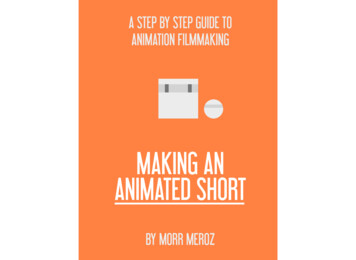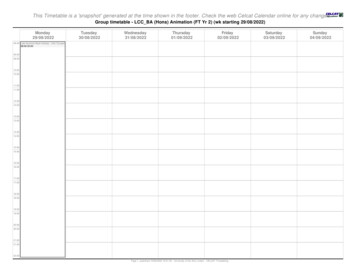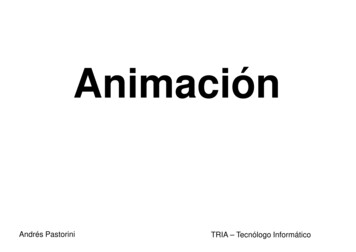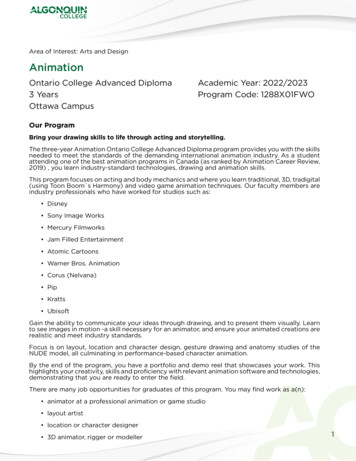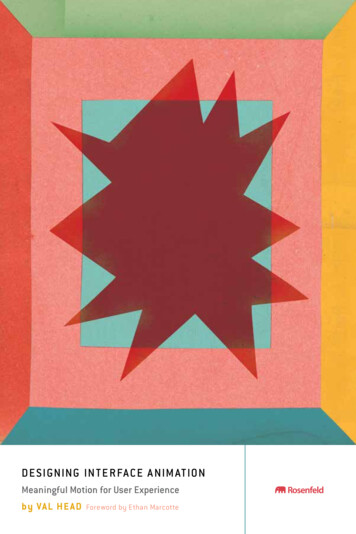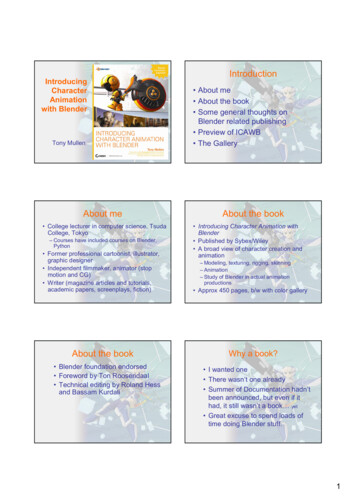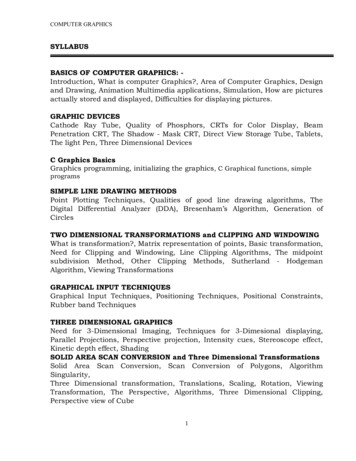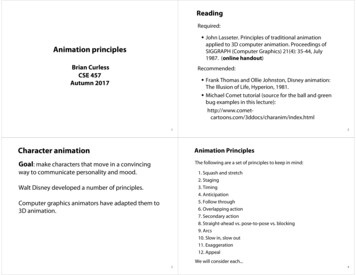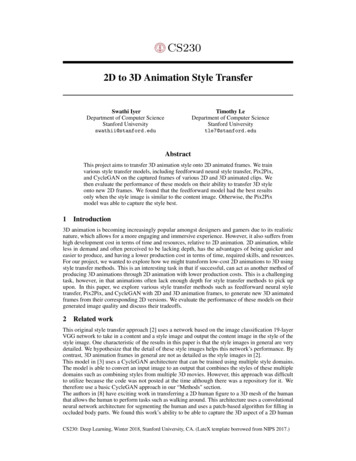
Transcription
2D to 3D Animation Style TransferSwathi IyerDepartment of Computer ScienceStanford Universityswathii@stanford.eduTimothy LeDepartment of Computer ScienceStanford Universitytle7@stanford.eduAbstractThis project aims to transfer 3D animation style onto 2D animated frames. We trainvarious style transfer models, including feedforward neural style transfer, Pix2Pix,and CycleGAN on the captured frames of various 2D and 3D animated clips. Wethen evaluate the performance of these models on their ability to transfer 3D styleonto new 2D frames. We found that the feedforward model had the best resultsonly when the style image is similar to the content image. Otherwise, the Pix2Pixmodel was able to capture the style best.1Introduction3D animation is becoming increasingly popular amongst designers and gamers due to its realisticnature, which allows for a more engaging and immersive experience. However, it also suffers fromhigh development cost in terms of time and resources, relative to 2D animation. 2D animation, whileless in demand and often perceived to be lacking depth, has the advantages of being quicker andeasier to produce, and having a lower production cost in terms of time, required skills, and resources.For our project, we wanted to explore how we might transform low-cost 2D animations to 3D usingstyle transfer methods. This is an interesting task in that if successful, can act as another method ofproducing 3D animations through 2D animation with lower production costs. This is a challengingtask, however, in that animations often lack enough depth for style transfer methods to pick upupon. In this paper, we explore various style transfer methods such as feedforward neural styletransfer, Pix2Pix, and CycleGAN with 2D and 3D animation frames, to generate new 3D animatedframes from their corresponding 2D versions. We evaluate the performance of these models on theirgenerated image quality and discuss their tradeoffs.2Related workThis original style transfer approach [2] uses a network based on the image classification 19-layerVGG network to take in a content and a style image and output the content image in the style of thestyle image. One characteristic of the results in this paper is that the style images in general are verydetailed. We hypothesize that the detail of these style images helps this network’s performance. Bycontrast, 3D animation frames in general are not as detailed as the style images in [2].This model in [3] uses a CycleGAN architecture that can be trained using multiple style domains.The model is able to convert an input image to an output that combines the styles of these multipledomains such as combining styles from multiple 3D movies. However, this approach was difficultto utilize because the code was not posted at the time although there was a repository for it. Wetherefore use a basic CycleGAN approach in our “Methods" section.The authors in [8] have exciting work in transferring a 2D human figure to a 3D mesh of the humanthat allows the human to perform tasks such as walking around. This architecture uses a convolutionalneural network architecture for segmenting the human and uses a patch-based algorithm for filling inoccluded body parts. We found this work’s ability to be able to capture the 3D aspect of a 2D humanCS230: Deep Learning, Winter 2018, Stanford University, CA. (LateX template borrowed from NIPS 2017.)
figure to be exciting. However, this work does not allow us to accomplish our task directly. We aretrying to produce a single 3D frame, not a 3D mesh. Additionally, this work does not necessarilygeneralize to animating non-human cartoon characters as well as the background. We could exploreconcepts of this architecture in order to capture 3D characteristics in the future.The authors in [4] use image analogies to apply to an input image. Using an autoregression model,this approach takes in a style A and an output style A0 ; this mapping from A to A0 is applied to a newinput image B so that B can be converted to B 0 . While this work requires manually collecting pairsof input and output style to learn analogies, this work demonstrates the effectiveness of having pairedimages in order for a model to learn a mapping.The work in [1] features manually transforming 2D cartoon clips of the TV show Rick and Morty to3D clips. The author of this work took sequential frames of 2D clips and used 3D animation softwareby overlaying these 2D frames and edited them. This appears to require much manual work while ourtask seeks to use deep learning to reduce the amount of manual work needed.3Dataset and FeaturesAll of our frames are from YouTube videos in which we did not run into copyright problemsdownloading. We used a tool called VLC media player to extract our frames. We adjusted therate at which frames were collected depending on how many images we needed; for example thefeedforward neural style transfer approach did not need as many frames as Pix2Pix and CycleGAN.Our initial approach featured collecting a few frames from the movie The Lion King (1994) as ourcontent image and a few frames from the movie Monster’s, Inc. (2001) as our style image to test howthe feedforward neural style transfer would perform on images with different environments whereasCycleGAN and Pix2Pix require images with similar environments.The pix2pix model required us to have exact frames in 2 different styles, in order to learn the mappingsbetween two images styles. To do this, we found an animator’s video [1] of his manual recreationof the 2D animated show Rick and Morty in 3D animation, and extracted the frames. In total, weextracted 82 frames, and divided the data into train/val/test splits of 80/10/10. We then used an onlinephoto editing tool called Birme to standardize image dimensions.For the CycleGAN method, for our training set, we have collected 53 frames from the 2D animatedThe Little Mermaid: Ariel’s Beginning movie, and 48 frames from the 3D animated Finding Dory. Asmentioned in [9], while there do not need to be explicit pairings for images for CycleGAN, best resultsoccur if the two domains share similar visual content. We therefore chose our content domain to beframes from The Little Mermaid: Ariel’s beginning (2008) and our style domain to be frames fromFinding Dory (2016) because both have underwater scenes. The low number of training set frames isa result of trying to have similar scenes in both movies. Primarily, we needed to remove scenes withmermaids because Finding Dory did not have underwater humans, and fast action scenes resulted inblurry images. After training our model, we found more scenes that had similar environments, so ourtest set included 45 frames from The Little Mermaid: Ariel’s Beginning and 81 frames from FindingDory. This small dataset is a limitation of using CycleGAN in our project.4Methods4.1Feedforward Neural Style TransferThe approach in [2] uses a network that has been pretrained on VGG. The network forms a representation of the content image and a representation of the style image. In order to generate an imagethat incorporates the content of one image and the style of another image, the network minimizes thedistance of a whitenoise image and the content representation as well as the distance of the whitenoiseimage and the style representation. The loss function has weights α and β that are used to factor howmuch the content versus the style representations affect the final outcome. The loss is:Ltotal ( p , a , x ) αLcontent ( p , x ) βLstyle ( a , x ),where p corresponds to the content image, a corresponds to the style image, and x corresponds tothe resulting image. As mentioned above, α and β are used to weight how much the content and stylerepresentations affect the outcome. We applied the Github repository in [6].2
4.2Pix2PixNext, we tried applying the Pix2Pix model in [5] by utilizing their Github repository. This modellearns a mapping, G : {x, z} y, from domain X and random noise vector z to domain Y , and thenapplies mapping to generate new images in domain Y .We found that this model would be applicable to our particular task as well, where we set domain Xto be 2D animated frames, and domain Y to be 3D animated frames. Because this model requiresexact pairings of images from the 2D to 3D animated style, we collected new data from frames of ananimator’s manual translations of the 2D animated show Rick and Morty to 3D animations to trainthis model.This approach uses a conditional GAN, where a discriminator D learns to distinguish between realand fake images (i.e. images produced by the generator), while the generator G is trained to produceimages that can fool the discriminator. In contrast to unconditional GANs that assume pixels in theimage to be conditionally independent from one another, conditional GANs use a loss that penalizesthe combination of output pixels. The loss for generator G and discriminator G is: LcGAN (G, D) E log(D(x, y)) E log(1 D(x, G(x, z)))x,yx,zHere, G tries to minimize the loss against an adversarial D that tries to maximize it. Therefore, thefinal objective of generator G is:G arg minG maxD LcGAN (G, D)The architectures of the generator and discriminator are both Conv-BatchNorm-ReLU blocksin a U-Net structure with skip connections between mirrored layers (adapted from [CHANGENUMBER][10]). This allows for low-level information, common to be important for image translations problems, to be directly shared across the network.4.3CycleGANWe chose to apply the CycleGAN approach in [10] to our task because this approach is meant tofind a mapping from domain X to domain Y without the images being paired. This model assumesthat there is some underlying mapping from domain X to domain Y . We used the following Githubrepository in [9]to apply this approach.The approach in [10] uses two mapping functions G : X Y to translate images in domain X todomain Y and F : Y X to translate images in domain Y to domain X. There are additionallytwo discriminator functions DX and DY that are used to discriminate whether of not an image is in arespective domain.Each mapping function and its associated discriminator function has a generative adversarial loss.The loss for G and the associated discriminator DY is: LGAN (G, DY , X, Y ) Elog(DY (y)) Elog(1 DY (G(x)))y pdata (y)x pdata (x)(There is also a similar loss LGAN (F, DX , Y, X) for F and the discriminator DX .)In addition to these functions, there is a cycle-consistency loss with a forward cycle-consistency lossand a backward cycle-consistency loss. The forward cycle-consistency loss ensures that for an imagex in domain X, F (G(x)) x. The backward cycle-consistency loss ensures that for an image y indomain Y , G(F (y)) y. Each cycle-consistency loss is intended to make G and F consistent withone another. This loss is expressed as follows: Lcyc (G, F ) E F (G(x)) x 1 E G(F (y)) y 1x pdata (x)y pdata (y)The full objective loss is:L(G, F, DX , DY ) LGAN (G, DY , X, Y ) LGAN (F, DX , Y, X) λLcyc (G, F ),where λ is a factor that controls the relative importance of Lcyc to that of the LGAN terms. The goalof CycleGAN is to find a G and F that solves the following:arg minG,F maxDX ,DY L(G, F, DX , DY )3
55.1Experiments/Results/DiscussionEvaluation MetricWe will evaluate our models based on a qualitative analysis of their output images, as well as onthe loss values. Using qualitative results is also done in [10] and [7]. We will report loss scores forthe feedforward network, but we note that the scores do not necessarily correlate with the outputimage quality. For example, the generated image in Figure 1 captures the 3D aspect better than thegenerated image in Figure 2, but Figure 1’s output has a higher loss.Figures 1 and 2 show the results of the feedforward neural style transfer, using style images thatare both similar and different from the content image, respectively. Figure 4 shows the results ofthe Pix2Pix model trained on paired Rick and Morty frames. Lastly, Figure 5 shows the results ofCycleGAN trained on Little Mermaid and Finding Dory.5.2Feedforward Neural Style TransferWe trained the feedforward model for 1000 epochs with a learning rate of 1e1 using the Adamoptimizer. We found that the feedforward model was the best at capturing the 3D style whilepreserving the content if the style image was similar to the content image. The Rick and Mortyimages, for example, gave results that very much looked 3D (Figure 1), as opposed to the LittleMermaid and Finding Dory frames (Figure 2), for which the model seemed to capture some of thecolors and preserved the content image really well, but didn’t necessarily capture the 3D style. Whilethe need for a similar style image is constraining, this result could still mean that fewer frames of amovie need to be created in 3D (e.g. perhaps only one frame per scene could be created in 3D, andapplied to the rest of the frames created in 2D). In addition, this model has advantages over Pix2Pixand CycleGAN, which require us to have several paired frames, or several frames from the samedomain, respectively, in constrast to feedforward, which only requires one style and content image,and relies on a pretrained model. Figure 3 demonstrates how the feedforward model does not performwell when the content and style images do not have similar content; the content for the outputtedimage is generally preserved, but the new style applied is not coherent with the entire output image.We note that training for more epochs as well as using higher quality images did not improve resultssignificantly and decreased the loss by a minor amount.The results in [2] feature style images that are detailed art works in general, but 3D animation framesare not detailed in a fine-grain manner. Therefore the lack of great results in Figures 2 and 3 may bedue to relatively low-detail style images. Figure 1 may feature better results because most of the styleand content frames map well to one another, so the model can map the coloring and the detail of thestyle image well to the content image despite a relatively low-detailed style image.Figure 1: Feedforward Neural Style Transfer results for Rick and Morty frames; content 2D frame(left), generated 3D frame (middle), style 3D frame (right); Loss: 548,076Figure 2: Feedforward Neural Style Transfer results for The Little Mermaid and Finding DoryFrames; Little Mermaid 2D frame (left), generated 3D frame (middle), Finding Dory 3D frame(right); Loss: about 462,0634
Figure 3: Feedforward Neural Style Transfer results for The Lion King and Monsters, Inc.; Lion King2D frame (left), generated 3D frame (middle), Monsters, Inc. 3D frame (right); Loss: about 718,9715.3 Pix2PixThe Pix2Pix model captured the 3D style of the animation very well, but was not as effective atpreserving the content. We see a general outline of all the features of the characters in the 3D style,but the outputs are not very defined and are still blurry. One thing we believe might be causing this isthat the true 2D and 3D frames are not exactly aligned. Perfectly aligned data is difficult to find aswell as to produce, but testing this would be a good next step.Figure 4: Pix2Pix Results; real 2D frame (left), generated 3D frame (middle), real 3D frame (right)5.4 CycleGANWe ran the CycleGAN model for 200 epochs with the Adam optimizer using an initial learning rateof 0.0002. We used λ 10. Despite having few training images, we see in Figure 5 that the contentimage is preserved for the most part in the generated image, but the style is not captured well. Whilean advantage of this approach is that the model is trained on images from our style and contentdomains and does not need to be paired, this lack of a quality generated image may be due to the datacollection challenges mentioned in the “Dataset" section. One metric of CycleGAN’s performance isthe recovered image in Figure 5 (the third image from the left); we see that although the edges of theimage are preserved, the image is very blurry. Having more training data would likely improve themapping from The Little Mermaid to Finding Dory and back to The Little Mermaid.6Conclusion/Future WorkOf all the models we tried, feedforward seemed to have the best results when the style image wassimilar to the content image. It preserved the content, while still producing images with the 3Dstyle. It was not, however, able to capture this style when the style image was significantly different.Pix2Pix seemed to capture the 3D style extremely well, however, the content was quite distorted,possibly due to the misalignment of the domain X and domain Y images. Testing this model withbetter aligned pictures is something we would like to explore more in the future. Although CycleGANFigure 5: CycleGAN results left to right: Little Mermaid 2D frame, generated 3D frame, 2D framerecovered from generated 3D frame, and 3D Finding Dory frame5
does not need paired images, it is still a challenge to gather images with similar environments. As afuture work, we would apply data augmentation techniques such as horizontally flipping the images.Additionally, because much of our project has focused on finding an architecture that suited our taskwell, with more time, we would like to experiment with modifying portions of a certain architecture.7ContributionsSwathi: Trained images on the feedforward neural style transfer model and the pix2pix model. Helpedwith data collection and preprocessing for pix2pix model.Timothy: Data collection and preprocessing. Helped with training images on the feedforward model.Trained images on the CycleGAN model.References[1] Den Beauvais. denbeauvais.com.[2] Leon A. Gatys, Alexander S. Ecker, and Matthias Bethge. A neural algorithm of artistic style.CoRR, abs/1508.06576, 2015.[3] Rui Gong, Wen Li, Yuhua Chen, and Luc Van Gool. DLOW: domain flow for adaptation andgeneralization. CoRR, abs/1812.05418, 2018.[4] Aaron Hertzmann, Charles E Jacobs, Nuria Oliver, Brian Curless, and David H Salesin. Imageanalogies. In Proceedings of the 28th annual conference on Computer graphics and interactivetechniques, pages 327–340. ACM, 2001.[5] Phillip Isola, Jun-Yan Zhu, Tinghui Zhou, and Alexei A Efros. Image-to-image translation withconditional adversarial networks. In Computer Vision and Pattern Recognition (CVPR), 2017IEEE Conference on, 2017.[6] Justin Johnson. neural-style. https://github.com/jcjohnson/neural-style, 2015.[7] Justin Johnson, Alexandre Alahi, and Fei-Fei Li. Perceptual losses for real-time style transferand super-resolution. CoRR, abs/1603.08155, 2016.[8] Chung-Yi Weng, Brian Curless, and Ira Kemelmacher-Shlizerman. Photo wake-up: 3d characteranimation from a single photo. CoRR, abs/1812.02246, 2018.[9] Jun-Yan Zhu, Taesung Park, Phillip Isola, and Alexei A Efros. Cyclegan. https://github.com/junyanz/CycleGAN, 2017.[10] Jun-Yan Zhu, Taesung Park, Phillip Isola, and Alexei A Efros. Unpaired image-to-imagetranslation using cycle-consistent adversarial networks. In Computer Vision (ICCV), 2017 IEEEInternational Conference on, 2017.6
This project aims to transfer 3D animation style onto 2D animated frames. We train various style transfer models, including feedforward neural style transfer, Pix2Pix, and CycleGAN on the captured frames of various 2D and 3D animated clips. We then evaluate the performance of these models on their ability to transfer 3D style onto new 2D frames.
